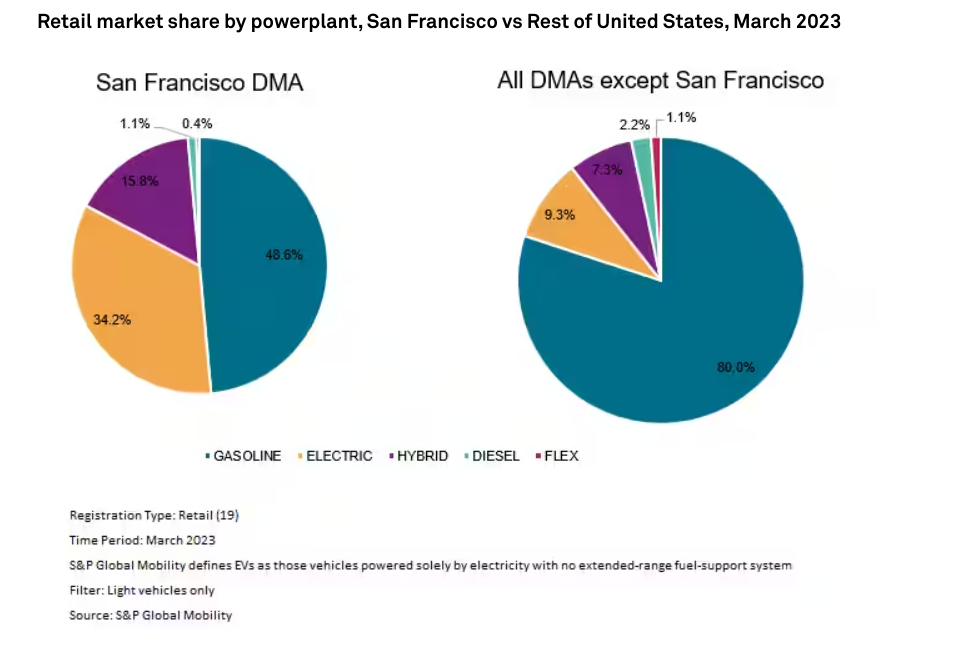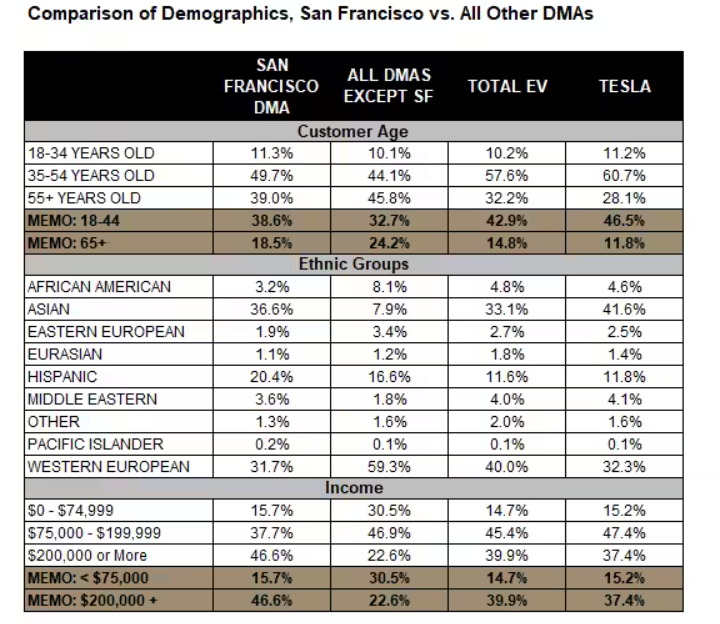
San Francisco area becomes first U.S. region to hit 50% EV adoption
By onMarket Trends
Half of new auto registrations in the San Francisco designated market area (DMA) were for electric vehicles (EVs), making the city the first in the nation to reach this level of adoption, according to a new report.
S&P Global Mobility shared new research this week that showed the San Francisco region’s 50% electrification rate, which includes both EVs and hybrid models, was more than three times greater than the national average of 16.6% during the same March period.
It said the milestone was not likely a fluke, as EVs represented 53.1% of new auto registrations in April.
“In reaching such lofty electrified registration numbers, several brands achieved shares of the EV market in the Bay Area far above their EV shares in the remaining DMAs,” S&P said.
“Predictably, Tesla’s share in the backyard of its original Palo Alto world headquarters and the Fremont home of its first U.S. assembly plant was almost five times its share in the rest of the country. Tesla’s share of the overall San Francisco EV market was 66.4% in March, with the brand accounting for almost one of every four new vehicles registered in San Francisco (across all fuel types and all brands).”

It noted that other EVs performed well in the area as well, with the Volkswagen ID4 and the Chevrolet Bolt more than quadrupling their market shares.
S&P said the reason San Francisco DMA is leading the EV charge boils down to two main elements: the similarities between San Francisco residents and typical EV customers, and the appeal of several EV brands outside of Tesla.
In the Bay area, it said new vehicle buyers tend to be younger. In March, 38.6% of new Bay area vehicle buyers were between the ages of 18 to 34, compared to a national average in that age category of 32.7%.
“The demographic makeup of the San Francisco market is similar to the profile of the EV buyer nationally, as reflected in several metrics,” S&P said. “Looking specifically at the ethnic mix, more than a third of all San Francisco buyers in March were Asian-American, slightly above the national EV average of 33.1% but more than four times the average across the rest of the United States. Further, Middle Eastern households represent 3.6 percent of all new vehicle registrations in San Francisco, near to the national EV mix of 4.0 percent but double the non-San Francisco average of 1.8%.”

The report noted another common element among EV buyers is that they tend to be wealthy. In San Francisco, nearly half of EV buyers had a household income of more than $200,000.
According to S&P, other U.S. regions are nearing 50% electrification as well, noting that Seattle and San Diego exceeded 35% in March. In other cities, including Portland, Los Angeles, and Sacramento, EVs represented more than 30% of new vehicle registrations during the same period.
The growing popularity of EVs in the San Francisco area is supported by a larger citywide initiative to be 100% emissions-free by 2040. The city is working to meet that goal by growing its public charging network, incentivizing residents to purchase EVs, and a public awareness campaign.
Infrastructure and cost
Questions have been raised about whether California’s grid is capable of supporting a large-scale transition to EVs, as it has historically been susceptible to blackouts during times of high usage.
The issue was explored in a CalMatters article, which laid out how a number of steps are necessary to prepare the state for an increase in EV charging. This includes charging cars during off-peak hours, leaning into renewable sources of energy, and increasing electricity production.
The rise in EV popularity will have unintended consequences for auto insurers, Moody’s Investors Service analysts said earlier this year.
Speaking during an April podcast, Jasper Cooper, vice president and senior credit officer at Moody’s, said because there is a small percentage of EVs on the road today, it isn’t having a significant impact on insurers.
However, as the share of BEVs increases, he said insurers are likely to start feeling more of a strain.
“The main effect is going to be higher repair costs that insurers are going to have to cover when there’s an accident,” he said. “The reason why EVs are more expensive to repair is one they have more expensive components, especially the batteries, and two, they’re more likely than regular internal combustion engine vehicles or ICE vehicles to need a full replacement once they’re in a collision. The replacement values for EVs are generally higher than for ice vehicles because their retail values are higher.”
Consumer reluctance
An earlier CCC Intelligent Solutions’ finding in 2022 indicated that the average small non-luxury EV model costs $4,041 to fix — about 27% more than the average for roughly comparable non-EV models — and concluded that EVs have lower maintenance costs but cost more if they’re damaged in a car crash or by bad weather. Among mid-size luxury SUVs, the difference was even more pronounced: $8,037 versus $5,242 for internal combustion engine (ICE) vehicles, according to CCC.
Meantime, a survey of more than 2,000 U.S. consumers found earlier this year that most drivers aren’t ready to make the switch to EVS citing list price, lack of charging stations, and battery range anxiety as their top concerns.
While those concerns are understandable, ValuePenguin says consumers should also consider higher auto insurance and repair costs.
“While your dealership probably won’t be upfront about the cost to insure an EV, they’re about 28% more expensive to insure compared to a gas car,” ValuePenguin’s Divya Sangameswhar said. “It would be good to talk to your insurer about how much your premiums may increase if you switch to an EV.”
A newly-released Verra Mobility Corporation study of 2,000 U.S. residents aged 25 and older found that 78% of people would consider renting an EV to try out the technology before committing to a purchase.
“Renting an EV is a helpful way to get drivers more comfortable and alleviate concerns,” said Steve Lalla, executive vice president of commercial services at Verra Mobility. “For many people, driving an EV isn’t intuitive. There’s anxiety around the unknown, like maintenance, locating charging stations and how to pay to recharge.”
Images
Featured photo credit: (Hoangrapherx/iStock)
Secondary images courtesy of S&P Global Mobility
